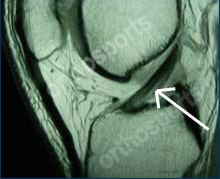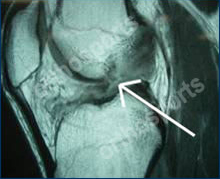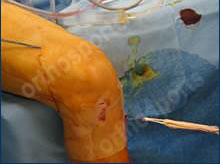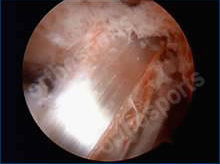The anterior cruciate ligament (ACL) is one of the major stabilising ligaments in the knee. It is a strong rope like structure located in the centre of the knee running from the thigh bone (femur) to the shin bone (tibia).
The anterior cruciate ligament prevents the femur moving forward and rotating abnormally on the tibia (this is particularly important when performing twisting actions). The ACL is usually not required for normal daily living activities such as walking in a straight line, however, it is essential in controlling the rotation forces developed during side stepping, pivoting and landing from a jump. This is particularly important if you are carrying a load.
When the anterior cruciate ligament tears or ruptures it does not heal itself and the knee often becomes unstable or gives way. Since the knee ‘dislocates’ when the ligament ruptures there is often damage to other structures in the knee such as bone, cartilage or meniscus at the time of the initial injury. Repeated giving way can lead to damage to other structures of the knee and eventually arthritis. This is because the shock absorbers (menisci) and joint lining surface (chondral cartilage) are progressively damaged with each giving way episode. These injuries may also need to be addressed at the time of surgery.
Usually there is a significant injury involving a twisting force to the knee. It can also occur after landing from a jump, stopping rapidly or direct contact such as in a tackle. ACL injury is particularly common in sports such as football, soccer, basketball, netball and skiing but can occur in many other activities. Whilst playing ball sports upon attempting a pivot, side step or land from a jump, the knee gives way. When skiing, the ACL is injured when the binding fails to release as the ski twists the leg. Swelling commonly occurs hours later rather than immediately. Frequently pain is felt on the outer aspect of the knee. The medial ligament of the knee joint may also be injured resulting in pain and swelling at the inner side of the joint. When the ACL ruptures the patient often feels something giving way in the knee or hears a popping sound. Most people cannot continue with their activity due to their knee pain and swelling.
The knee should be treated with ice, elevation and a compressive bandage. Crutches and pain killers usually are required for a few days. An X-ray is necessary to exclude an associated fracture. Physiotherapy is helpful to reduce swelling and regain motion.
Most patients will be referred to an Orthopaedic surgeon for diagnosis and assessment of the injury. Careful clinical examination is required to detect damage to the ACL, other ligaments and structures in the knee such as the meniscus or articular cartilage. It is quite common to damage some of these other structures.
The diagnosis of a ruptured ACL (tear) can usually be made on history and clinical examination. A special non radiation imaging test called an MRI scan is often ordered to confirm the diagnosis (although in some patients the examination is conclusive). It also demonstrates damage to other structures such as the menisci or articular cartilage. The diagnosis can also be made with an arthroscopy.


The goal of treatment of an injured knee is to return the patient to their desired level of activity, hopefully without risk of further injury to the knee. Most patients who tear their ACL during sport will elect to have it surgically reconstructed to enable them to return to full activities with a stable knee. Other patients choose to modify their activities and give up sport to avoid further episodes of instability.
In general, the younger and more active you are then the stronger the recommendation is for reconstruction. It is usually necessary to have surgery if you wish to get back to sports which involve twisting and pivoting. Many patients who do not have surgery find that their knee becomes more loose over time. This can lead to a knee that gives way during ordinary activities of daily living. These patients should strongly consider ACL reconstruction surgery to stabilise the knee and prevent damage to the other structures in the knee.
Repeated instability or abnormal movement in the knee can cause ongoing damage leading to stretching of other structures around the knee. Tearing of the meniscus or joint lining cartilage damage both lead to arthritis in the long term. If you do not elect to have surgery it is strongly advised that you give up sports that involve pivoting, sidestepping or rotation.
It is also recommend that people with dangerous occupations such as policemen, firemen, roof tilers and scaffolders have surgery. This is a safety issue to prevent instability in ‘at risk’ situations.
There is no urgency in performing this operation and in fact it is sometimes better to allow the knee to settle down and regain close to full motion prior to surgery.
Conservative treatment is guided by a physiotherapist. It is designed to restore range of motion to the knee joint, reduce swelling and restore full muscle power. The nerves around the knee are injured when the ACL tears. This causes what is termed ‘loss of proprioceptive function’ to the knee. Proprioceptive retraining to develop the necessary protective reflexes are performed to protect the knee joint during normal daily living activities. It is important to alter your sports to the ones involving straight line activity only. For some people social (non-competitive) sport is still possible without the knee giving way as long as you do not change direction suddenly.
A torn ACL never heals. All reconstructive procedures for the ACL require a graft to replace the torn ligament. My usual reconstructive technique involves replacing the torn ACL with segments of your hamstring tendons but in some cases the middle third of the patella tendon or a strip of the quadriceps tendon can be used. Whichever graft is used it is securely fixed to allow rapid rehabilitation of the knee. This is often referred to as an accelerated ACL rehabilitation programme. The long term results of surgery suggest that stabilising the joint protects the menisci and decreases the chance of developing osteoarthritis later in life. The end result of the operation for you will depend largely upon whether you complete a satisfactory rehabilitation programme or not.
Getting ready for your operation
Cease aspirin and anti-inflammatory medications (Voltaren, Feldene, Advil, Brufen etc) 10 days prior to surgery as they can cause bleeding.
Cease any naturopathic or herbal medications 10 days before surgery as these can also cause bleeding.
Continue with all other medications unless otherwise specified.
Notify me if you have any scratches, abrasions or pimples around the knee.
Please bring any X-rays, MRI scans or other investigations you have had done which may be relevant to your surgery.
Bring a list of medications with you to give to the anaesthetist.
Most patients are admitted on the morning of their surgery and discharged early the next day.
You should not to shave or wax your legs for one week prior to surgery.
You are advised to stop smoking for as long as possible prior to surgery.


The hamstring tendons are harvested through a small incision (skin cut) just below the knee and are fashioned into a new graft which takes the place of your old anterior cruciate ligament. An arthroscopy of the knee is performed to deal with any meniscal (cartilage) or chondral (joint lining) damage. Tunnels (holes) are then drilled in the tibia and femur (the two bones making up the knee joint) and the graft is passed through this tunnel. The graft is then fixed at each end to stabilise it and allow it to heal to the bone.
During your ACL reconstruction operation, local anaesthetic is injected into the knee to reduce the amount of pain you will feel. Pain relieving medication will be provided for you both in hospital and at home.
A drain is left in your knee overnight and removed early the next day. You will have waterproof dressings on your wounds and a compressive bandage on the leg.
You will be seen by a physiotherapist prior to discharge who will teach you how to use crutches and show you some simple exercises to do at home. Your dressing should be left intact until your first postoperative visit.
Ice packs should be used regularly to reduce swelling.
Your graft is strong enough to put all your weight on your operated leg. You can walk around but rest as much as possible for the first week and elevate your leg when sitting. The crutches are not designed to stop you walking on the leg but do prevent you from injuring the graft if your leg buckles under you.
Pain is variable and prescription pain killers may be required for a week or two.
You may shower but not bath or swim prior to seeing me. It is normal to have blood under the dressing. If there is excessive ooze the dressings can be changed by someone experienced in wound care. If you are concerned please contact me.
You will be seen at my office about 10-14 days after your operation when the dressings will be removed and the wounds inspected. The surgery and any other findings will be explained to you.
If there is any redness, increased swelling or you have temperatures, chills or sweats you should contact my rooms or the hospital where the surgery was performed so they can contact me.
Time off work depends on your work requirements and is very variable. Office workers usually require 2 weeks off work and manual labourers 2 to 3 months or longer.
Driving an automatic car is possible as soon as pain allows after left knee surgery. If you have had a right knee ACL reconstruction then driving may not be possible for weeks or even months. You need to be able to brake safely in an emergency situation before you drive (please consult the RTA for more details).
Physiotherapy is an integral part of the treatment and is recommended to start as early as possible after your ACL reconstruction surgery. Preoperative physiotherapy is helpful to better prepare the knee for surgery. The early aim is to regain range of motion, reduce swelling and achieve full weight bearing.
The remaining rehabilitation will be supervised by a physiotherapist and will involve activities such as exercise bike riding, swimming, proprioceptive exercises and muscle strengthening. Cycling can begin at 4 weeks, jogging can generally begin at around 3 months. The graft is strong enough to allow sport at around 6 months however other factors come into play such as confidence, fitness and adequate fitness and training.
Professional sportsmen often return at 6 months but recreational athletes may take 10 -12 months depending on motivation and time put into rehabilitation. A return to competitive sport is permitted provided that there has been a complete rehabilitation (including the PEP or FIFA11+ program).
The rehabilitation and overall success of the procedure can be affected by associated injuries to the knee such as damage to meniscus, articular cartilage or other ligaments.
Despite advances in surgical technique and the utmost care being taken during surgery, complications can still occur. It is very important for patients undergoing an ACL reconstruction to understand the reasons for the procedure and to have a major role in making an informed choice to proceed with surgery rather than non surgical treatment.
You may notice a numb patch on the outer aspect of your leg just past where the skin has been cut. The numb patch tends to shrink with time and does not affect the result of the reconstructed ligament.
Your hamstring musculature will recover quickly and tendon ‘regrowth’ may be felt at 14 days following surgery. This is actually scar tissue forming where the tendons used to be. This scar tissue may tear and is felt as a pop or tear behind the knee on the inner side. This will usually set your rehab back a few days only and usually occurs before 6 weeks.
Graft failure occurs in < 1% of grafts and unfortunately is impossible to predict.
After ACL surgery there is a < 1 in 400 chance of developing an infection within the joint and we work very hard to keep this number very low.
As with all operations, if at any stage you are worried, it is better to call for advice rather than wait and find out you should have done something different.
In general ACL reconstruction surgery is very successful and the majority of patients are able to return to their desired sport. Complications can occur with any surgical procedure (including rare or unexpected complications). This is an elective procedure and as the patient you need to make an informed decision on whether or not to proceed with surgery. Since the anterior cruciate ligament never heals, the majority of young active people end up choosing to have an ACL reconstruction.
Click here to watch a video animation of an ACL reconstruction
Click here to watch a video of an ACL reconstruction